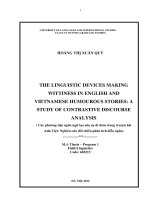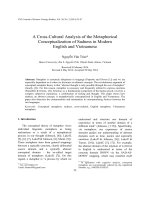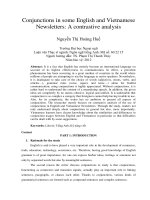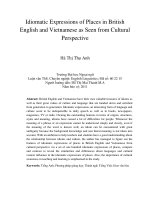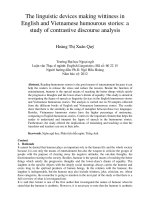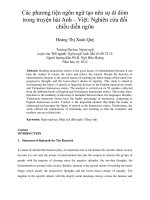The linguistic devices making wittiness in the English and Vietnamese humorous stories A study of contrastive discourse analysis
Bạn đang xem bản rút gọn của tài liệu. Xem và tải ngay bản đầy đủ của tài liệu tại đây (198.01 KB, 13 trang )
Các phương tiện ngôn ngữ tạo nên sự dí dỏm
trong truyện hài Anh – Việt: Nghiên cứu đối
chiếu diễn ngôn
Hoàng Thị Xuân Quý
Trường Đại học Ngoại ngữ
Luận văn ThS ngành: Ngôn ngữ Anh; Mã số: 60 22 15
Người hướng dẫn: Ph.D. Ngô Hữu Hoàng
Năm bảo vệ: 2012
Abstract: Reading humourous stories is the good means of entertainment because it can
help the readers to release the stress and reduce the tension. Beside the function of
entertainment, humour is the special means of reaching the better things which satisfy the
progressive thoughts and the lower-class’s dream of equality. This study is aimed at
investigating the figure of speech as linguistic devices in the English humourous stories
and Vietnamese humourous stories. The analysis is carried out on 50 samples collected
from the different books of English and Vietnamese humourous stories. The results show
that there is the similarity in the using of metaphor between these two languages. Besides,
Vietnamese humorous stories have the higher percentage of metonymy, comparing to
English humourous stories. Context is the important element that helps the reader to
understand and interpret the figure of speech in the humourous stories. Furthermore, the
study offered the implications of translating and teaching so that the translator and
teachers can use in their jobs.
Keywords: Ngôn ngữ học; Phân tích diễn ngôn; Tiếng Anh
Content
INTRODUCTION
1. Statement of Rationale for The Research
It cannot be denied that humour plays an important role in the human life and the whole society
because it is not only the means of entertainment but also the weapon to criticize the groups of
people with the purpose of clearing away the negative attitudes, the out-date thoughts, the
discrimination existing in the society. Besides, humour is the special means of reaching the better
things which satisfy the progressive thoughts and the lower-class’s dream of equality. The
laughter at the specific objects with the deeply social meanings always carries the humour and
exists long in the spiritual products of human beings. In the relation with the humour, the
laughter is indispensable, but the humour may also include wittiness, joke, criticism, etc. About
these categories, the researcher is going to mention in the next part of the study so that there is a
full overview of what is investigated into.
It can be seen that there have not been any study of HS under discourse analysis and contrastive
between English and Vietnamese implemented before by any researchers in Vietnam, so the
author of this study believes that this would be the first time this subject is carried out and hopes
that it would be new approach to the humour under discourse analysis in Vietnam as well as to
the literature of which HS are the object of the study. In addition, the study would be helpful for
the translators to be good at their translation from English and Vietnamese and vice verse
because when reading the literature works, in terms of the discourse analysis views, the readers
not only understand the humour mechanism, the linguistic devices, the nature of humour, etc but
also are supplied with the knowledge of language, people characteristics, attitudes and thoughts
of the culture the stories belong to. Besides, the study also is necessary for the teachers in their
jobs because it is said that the successful teacher need to have good sense of humour. Through
the study, the knowledge would be helpful for them to tell the jokes in the appropriate time to be
the warm-up activities.
2. Aims of the study
- In the study, the researcher investigates the figure of speech as linguistic devices making
the wittiness and then help us to understand/explain why people laugh when reading EHS
and VHS.
- The role of context in the HS, then readers can understand the jokes by the context when
reading them.
- To provide implications for the translators to understand the jokes in the stories and have
good interpretation with the right transfer. Besides, it is necessary to tell HS in language
teaching, then the students can be supplied with language knowledge, cultures and
motivated in learning, warm-up activities and release their study tension.
3. Scope of the study
The types of humour can be cartoons, funny pictures, plays, etc. However, this study is limited to
the verbal humour. The object of research is the EHS and VHS.
This research is limited to investigate the figure of speech as the linguistic devices like metaphor,
metonymy and others which make the wittiness in the selected EHS and VHS
4. Method of the study
By means of quantitative method, the investigation is carried out through text analysis, previous
researches, individual analysis and observations.
Data are gathered in the books collection of EHS and VHS.
Based on the collected books, the samples shall be sorted out in terms of the figure of speech as
linguistics devices and types of the theory of humour
DEVELOPMENT
CHAPTER 1: THE THEORETICAL BACKGROUND
In this chapter, the researcher offers the literature review and theoretical background related to
discourse, humour and linguistic devices as metaphor and metonymy.
1.1 Discourse
1.1.1 Definition of discourse
1.1.2 Types of discourse
1.2 Context
1.3 Humour and its categories.
1.4 Overview of HS
1.5 The Incongruity Theory in Humour
1.6 Figure of Speech as Linguistics Devices in HS
1.6.1Metaphor
1.6.2Metonymy
CHAPTER 2: THE STUDY
2. 1 Methodology
2.1.1 Data Collection
The main aim of this section is to explore how figure of speech as linguistic devices is used in
the stories. The researcher found 50 samples which are collected from the selected books. The
samples are from the books: 120 English-Vietnamese HS (episode 1 and 2), Best Funny Stories,
The World of English Humour, Teacher – Jokes, Quotes, And Anecdotes, Nụ Cười Nước Anh,
Tiếu Lâm Việt Nam Hiện Đại, Cười…Hở Mười Cái Răng, Truyện cười dân gian Việt Nam
2.1.2 Procedure
The display of the data classification will be done by means of tables in which the type of jokes
in English and Vietnamese will be reflected, as well as the pieces of text to be described and
analyzed.
After doing the in-depth analysis, the cases of each phenomenon in each field will be quantified
and the results are reflected in tables. The count will be done manually and calculated in the
percentage.
2.2 Data Analysis
The researcher found there are 50 samples in the selected books of HS as mentioned, in which
metaphorical jokes are 37 and metonymical jokes are 13. The metaphor jokes and metonymy
jokes are subdivided into the categories of English and Vietnamese.
2.2.1 Metaphor
The aim of the study deals with the metaphor as linguistic device, so this part was paid special
attention because of the purpose of the study. A total of 37 samples as metaphor jokes in the
books of humorous stories, there are 18 (49%) and 19 (51%) in the English and Vietnamese
respectively. Overall, this means that the difference between these two languages is rather small.
Table 1 reveals the frequency and percentage of metaphor jokes occurring in total and between
two languages in particular.
Table 1: Metaphor jokes in EHS and VHS
Metaphor jokes
Percentage
EHS
18 jokes (49%)
VHS
19 jokes (51%)
It can be seen from Table 1 that the percentages of EHS and VHS are rather equal. There are the
equivalent percentages of metaphor jokes, the findings indicate that both the English and the
Vietnamese are fond of using metaphor as the linguistic devices in their humours stories.
2.2.2 Metonymy
Metonymy is the other linguistics device that the researcher investigates in this study. The
number of metonymical jokes are 13, in which English jokes are 5, account for 38% and
Vietnamese jokes are 8, accounting for 62%. The results of metonymy jokes in English and
Vietnamese are presented in table 2.
Table 2: Metonymy jokes in EHS and VHS
Metonymy jokes
Percentage
EHS
5 jokes (38%)
VHS
8 jokes (62%)
With regard to the percentage of metonymy jokes in the table 2, this study found a big different
result. According to the finding, metonymy jokes in VHS have the majority, accounting for 62%.
This means that there is the difference in the culture of two countries in using figure of speech in
communication. It seems that Vietnamese people are more fond of using metonymy to display
the referential function, it allows them to use one entity to stand for another. While the English
metonymy is not often used in the jokes, the Vietnamese metonymies are favored when talking
about the place for the institution.
2.3.1 Discussion and Contrastive Findings
2.3.1 Context in the interpretation of jokes in the HS
During investigation, the researcher found that context is one of the substantial elements that
help the reader to understand the stories and interpret the jokes.
In the stories, we find that there are linguistic and non-linguistic contexts. The term woodeater, is
the linguistic context and it is related to the language in the triangle: language – communication
– context. By analyzing some features of context, we can make clear the implicature in the
stories.
2.3.2 Contrastive Findings between EHS and VHS
2.3.2.1 Similarities
The only similarity is that metaphor as the linguistic device is used much by both English and
Vietnamese. This means the figure of speech’s using plays an important role in the creating joke
to satisfy the amusement, criticism or other purposes in both cultures. Once again, the researcher
agrees with the idea of George Lakoff & Mark Johnson (1984: 10), in which our ordinary
conceptual system is fundamentally metaphorical in nature and metaphor is pervasive in
everyday life, not just language, our thought and action. Besides, irrespective of differences in
culture, there are some concepts are universal, i.e. people at all levels and of any culture can
employ and interpret the metaphor because it has the similarities in source domain and target
domain. Here the researcher is not claiming that all cultural values coherent with a metaphorical
system and all things are equal in value because there has been still the conflict between the
concepts and the values among the languages.
2.3.2.2 Differences
The difference is that VHS account for the bigger percentage of metonymical jokes. It is possible
that the Vietnamese are fond of using one entity to refer another which is in the relation, then to
provoke the laughter in the jokes. Metonymy performs the function of reference or substitution,
and serves the purpose of identifying the particular characteristic of the entity or person. Because
the way we conceptualize the things in the world and the fundamental values in the cultures are
different, there is a direct physical or casual association (the relationship existing in the nature of
metonymy). Here the researcher support with George Lakoff & Mark Johnson, G (1984:35)
when two both linguistics claimed that metonymies are grounded in our experience and provide
an essential means of comprehending the cultural concepts.
It seems that Vietnamese people are really fond of using the humour to be the means of
criticizing the individuals and groups in the society, and when laughing, they have the feeling of
criticism and the amusement better than others. One more thing is that Vietnamese has a history
under the rule of Northern Feudal Oppression, people suffered from the sorrow, the separation,
the misery, so humour played a central role in the people’s entertainment and the struggle for the
working class and with the enemy of country. In the modern time, the mechanism of national
organizations with the negative effect, corruptions caused by the low educated officials is
another reason why Vietnamese people use much figurative speech in their HS.
Chapter 3: IMPLICATIONS OF TRANSLATION AND TEACHING
3.1 Implications of translation
Through investigation, it is noted that there are some terms and sentences which are translatable,
difficult to be translatable and untranslatable. Thus, how to be good at transferring from the
source language into target language in the humorous stories is a challenge to the translator.
The laughter arises from the incongruity and the relief of sex in which metaphors are used like
the figurative imagination. The incongruity between sex and body parts (what it is compared)
caused the laughter. In this story, the researcher is difficult to translate the terms like the
beginning of the land development (translated from điểm phát long chi sơ), the joint- tiger and
dragon land (translated from đất long hổ cựu toàn) and the land making the bird lose its
direction (translated from bãi bình sa lạc nhạn). The similarities between two languages allow
the translator to evaluate how much a translated joke differs from the source joke.
For the untranslatable terms and sentences, it is noted that there are other cultural aspects
existing in Vietnamese and English as well and such aspects be transferred to other cultures by
ways of translation
As we also have stated elsewhere in the text, the description of both humour and translation, as
two separate concepts, are not available in certain and decisive terms. From the viewpoint of its
cultural features, the original humor may include a concept or concepts which are totally
unknown in the target culture. The humor translators’ mission is to overcome these challenges;
to understand the historical and social nuances of the humor, approximate to its style, transfer the
linguistic features and cultural concepts, as much as possible, to the extent that it makes the
target audience laugh when reading or hearing the humor in his own language.
3.2 Implications of Language Teaching
It is often claimed that humour is a desirable characteristic of teaching and learning. However,
the teacher should choose the topics of jokes, depending on the age and level of students. If the
students are elementary and high school, the sex jokes are not appropriate for them because they
are taboo. According to the investigated in this study, some sex jokes has body parts which are
figurative meanings and very sensitive like the metaphor of bird or subleg. If the topics are good
and educational, the teachers can provide the students with knowledge in English language and
culture and. One more thing is that the teachers need to consider the suitable time to tell the
jokes. It is better for them to offer the student with the HS when they are tired and bored at the
lessons. Another good time is at the beginning of the lesson, then the students can be warm up by
the exciting atmosphere
CONCLUSION
1. Major findings
About metaphor, it is used quite equally with the percentage of 49 % for EHS and 51% for VHS
respectively. From this finding, we can conclude that at any cultures, the linguistic device of
metaphor is favored and we can laugh at the metaphoric jokes with the universal interpretation.
Beside the universal concept, it can be denied that there have been still the different ones among
the cultures when the source and target domain are not the same.
About metonymy, the study discovered that the most frequency of metonymy exists in the
Vietnamese stories, compared to English ones.
Additionally, the other result shows the sharing of the incongruity theory of humour by both
Vietnamese and English humourous. From this finding, we can see that there is a difference of
two cultures, and the Vietnamese tend to amuse at the individuals and groups to laugh at. The
humour accompanies the working class to the better society which is the dream of the
Vietnamese people. Suggestions for the translators, teachers and a further study
2.1 Suggestion for the translator and teachers
First, the translators need to have a good system of English and Vietnamese lexemes – semantics
– grammar with the understanding of the nature’s metaphor and metonymy as the linguistic
devices in the HS. Second, the translator need to build up the good knowledge of the cultures,
and the difference of cross-culture to see which characteristic is universal or not.
2.2 Suggestions for a further study
Due to the limited time, the scope and focus of the thesis, there are some points that have not
been investigated by the researcher. In this study, the researcher just focused on one theory
which is known as the incongruity in the relation of figure of speech as linguistic devices. It is
interesting to explore two other theories: the superiority and the relief in the relation of metaphor
and metonymy. By this way, we are able to know the figure of speech belongs to the superiority
or the relief. For some authors, the superiority is involved in the social discrimination and the
relief is involved in the taboos. Exploring the figure of speech as linguistic devices in the relation
with these two theories would be the effective way for us to understand the stories’ characters’
thoughts, attitudes and feelings towards the society where they live in as well as their desire to
release the sex energy and other taboos.
References
Book sources:
Bassnett, S.(1992). Translation studies (p.p21). London: Routledge.
Đặng Việt Thủy. (2010). Tiếu Lâm Việt Nam Hiện Đại (p.p6-277). Thanh Hóa: Nhà Xuất Bản
Thanh Hóa
Đức Tài. (2012). Truyện Hay Quốc Tế - The World Of English Humour. (p.p3-105). TpHCM:
Nhà Xuất Bản Dân Trí
Đức Tài & Diên Khánh (2012). Truyện Hài – Best Funny Stories (p.p3-105). TpHCM: Nhà Xuất
Bản Dân Trí.
Finegan, E. (2004). Language: Its Structure and Use (p.p197). Boston & Massachusetts:
Thomson-Wadsworth.
Lobner, S. (1999). Understanding Semantics (p.p48-51). London: Arnold
Lakoff, G & Jonhson, M. (1984). Metaphor We Live By (p.p3-35). Chicago & London: The
University of Chicago Press.
Levinson, C, S. (2000). Pragmatics (p.147). Cambridge: Cambridge University Press.
Nunan, D. (1993). Introducing Discourse Analysis (p.p5-51). England: Penguin English.
Nguyễn Quốc Hùng. (2009). Nụ Cười Nước Anh. (p.p 5-324). Hà Nội: Nhà Xuất Bản Thanh
Niên.
Nguyễn Thị Hồng Nhung. (2010). Implicature in English and Vietnamese Humourous Stories
(p.37). Hà Nội: University of Language and International Study Language
Ngọc Hà. (2012). Truyện Cười Dân Gian Việt Nam (p.p5-180). Hà Nội: Nhà Xuất Bản Văn Hóa-
Thông Tin
Nguyễn Hòa. (2008). Phân Tích Diễn Ngôn – Một Số Vấn Đề Lí Luận Và Phương Pháp (p.p1-
281).Hà Nội: Nhà Xuất Bản Đại Học Quốc Gia Hà Nội.
Nguyễn Hòa. (2000). An Introduction to Discourse Analysis (p.p43). Hà Nội: Đại Học Quốc Gia
Hà Nội.
Nguyễn Hoàng Yến (2011). Truyện Cười Dân Gian Việt Nam Dưới Góc Độ Dụng Học (p.110).
Hà Nội: Học Viện Khoa Học Xã Hội
Nguyễn Thiện Văn & Lương Vĩnh Kim (2008). 120 Mẩu Chuyện Vui Anh-Việt – 120 English-
Vietnamese Humourous Stories. (1). (p.p4-145) Đà Nẵng: Nhà Xuất Bản Đà Nẵng
Nguyễn Thiện Văn & Lương Vĩnh Kim (2008). 120 Mẩu Chuyện Vui Anh-Việt – 120 English-
Vietnamese Humourous Stories. (2). pp4-145 Đà Nẵng: Nhà Xuất Bản Đà Nẵng
Ross, A. (1998). The Language of Humour (p.p1-63). London & New York: Routledge
Richards, J, C, Platt, J & Platt, H. (2000). Dictionary of Language Teaching & Applied
Linguistics. USA: Longman
Saeed, I, J. (2003). Semantic Description (p.345). Oxford: Blackwell Publishing
Tam Tam (2011). Cười…Hở Mười Cái Răng (p.p3-299). TpHCM: Nhà Xuất Bản Thanh Niên
Vũ Ngọc Khánh. (1996). Hành Trình Vào Xứ Sở Cười. Hà Nội: Nhà Xuất Bản Giáo Dục.
Internet sources:
Internet 1: Attardo, S. & Raskin, V. (1994). Linguistics Theory Of Humour. (p.p1-20). Retrieved
from
/>summary_r&cad=0#v=onepage&q&f=false
Internet 2: Armali, F. (2012). Loss And Gain In Humour Translation; A Case Study Of The
Ethics Of The Aristocrats (p1-3). Retrieved from
/>case-study-of-The-Ethics-of-the-Aristocrats
Internet 3: Dynel, M. (2009). Creative Metaphor Is A Birthday Cake: Metaphor As The Source of
Humour (p.p29-31). Retrieved from />cake-metaphor-as-the-source-of-humour-w1633
Internet 4: Freud, S. (1960). Jokes and Their Relation to The Unconscious. Retrieved from
/>unconscious+by+Freud&dq=jokes+and+their+relation+to+the+unconscious+by+Freud&source=
bl&ots=hV52WB2Ok-
&sig=unbu7JM2a8l4PYZweK1wteywoks&hl=en&sa=X&ei=0xhXUMWtMPCziQfJ04CoBw&
ved=0CC0Q6AEwAA
Internet 5: Hobbes, T. (1958). Leviathan. (c.8). Retrieved from
/>bbes&dq=Human+Nature+by+Thomas+Hobbes&source=bl&ots=tTJGnkeZDF&sig=SkZ4nVpZ
vQOi3UeIstB3H5iebgU&hl=en&sa=X&ei=tR1XUIPxMcSOiAfsi4G4CA&ved=0CDIQ6AEwA
Q
Internet 6: Hantoro, S. (2008). The Violatd Maxims And The Illocutionary Act Types Found In
Humour Comic of Master Q. (p.p6-7). Retrieved from http://hantoro-
hsp.blog.com/2008/09/violated-maxims-and-illocutionary-act_17.html
Internet 7: Krikman, A. (2006). Contemporary Linguistic Theories of Humour (p.p33-36).
Retrieved from
Internet 8: Jarande, A. (2006). What Humour Tells Us About Discouse Theories. (p.31).
Retrieved from
Internet 9: Lippit, J. (1995). Humour and Superiority. (p.11). Retrieved from
Internet 10: Nguyễn Đức Dân. (1977). Ngôn ngữ, Lô-gic và những ‘nụ cười’ (p.1). Retrieved
from
Internet 11: Nguyễn Thiện Khanh (2011). Truyện Cười và Ngôn Ngữ. (p.1-4). Retrieved from
Internet 12: Nieto, R. (2011). Humour in Woody Allen’s Anything Else. (p.p20-21). Retrieved
from
Internet 13: Sachiko Kitazume. (2006). Cognitive Models of Humor and Metaphor. (p.p1-33).
Retrieved from
/>&url=http%3A%2F%2Fkurepo.clib.kindai.ac.jp%2Fmodules%2Fxoonips%2Fdownload.php%3
Ffile_id%3D3097&ei=XtxXUNfPDeXZigfR1oHoAw&usg=AFQjCNEz8xbveSPrtz4JOjoIfXk8
Zdj_sA
Internet 14: Schopenhauer, T & Kant, I. (1970). The Critique of Judgment. (p.77). Retrieved
from
/>+Judgement+by+Schopenhauer&source=bl&ots=54lfSU973D&sig=QcGkKArd7m_2nOTSHBL
eWYogT6M&hl=en&sa=X&ei=HRxXUM2HEcWaiAeVyICoDg&ved=0CDkQ6AEwAg#v=on
epage&q&f=false
Internet 15: Trần Thiện Khanh. (2009).Bước Đầu Nhận Diện Diễn Ngôn, Diễn Ngôn Văn Học,
Diễn Ngôn Thơ (p.p1-3). Retrieved from http://khoavanhoc-
ngonngu.edu.vn/home/index.php?option=com_content&view=article&id=1464%3Abc-u-nhn-
din-din-ngon-din-ngon-vn-hc-din-ngon-th-bai-1&catid=94%3Aly-lun-va-phe-binh-vn-
hc&Itemid=135&lang=vi
Internet 16: Veale, T. (2003). Metaphor and Metonymy: The Cognitive Trump-Cards of
Linguistic Humour. (p.p1-3). Retrieved from
Internet 17: Veiga, J, M. (2009). Linguistic Mechanism Of Humour Subtitling. 4
th
Forum for
Linguistic Sharing. Retrieved from
Internet 18: Yakin, Orhun (1999) Translation of humour with special reference to the cartoons in
'Leman' and other popular weekly humour magazines of Turkey. PhD thesis, University of
Warwick. Retrieved from:
Internet 19: Wei Liu (2010). Cohesive Device Analysis in Humor. (p.1). Retrieved from
Internet 20:
Internet 21: />cuoi.html
Internet 22:
/>&url=http%3A%2F%2Fwww.lexically.net%2Fwordsmith%2Fcorpus_linguistics_links%2FRoe
mer%2520208%2520HSK%2520CL%2520chapter%2520final%2520print%2520version.pdf&ei
=EllqUNyINdHQrQeW84GIAw&usg=AFQjCNHNF01Tu-8bR7KXwlBvJC0UHg2cmQ
Internet 23:
Internet 24:

